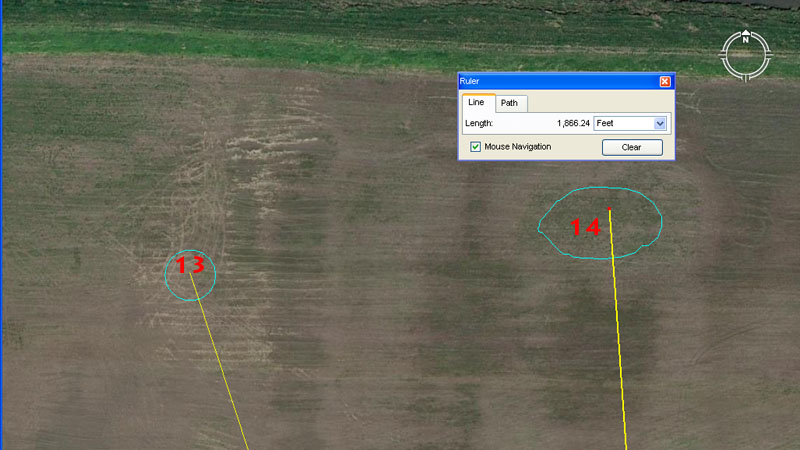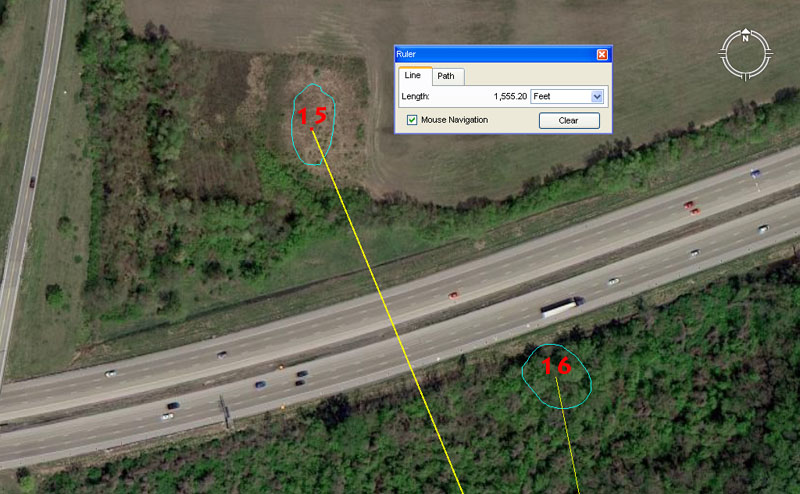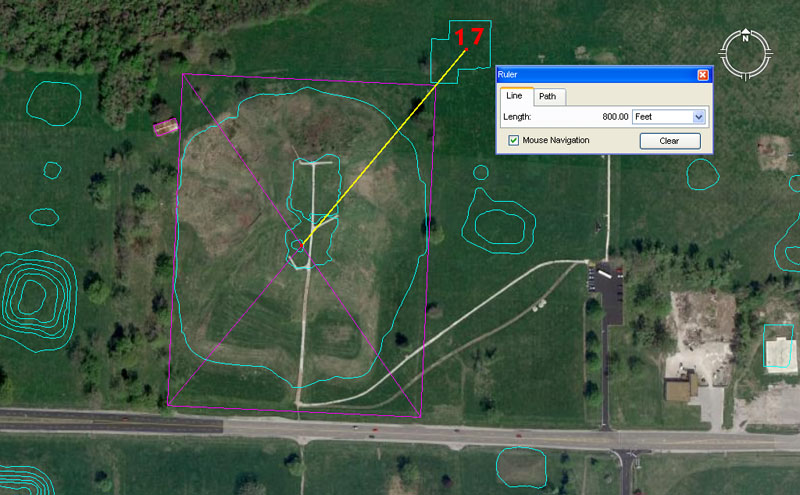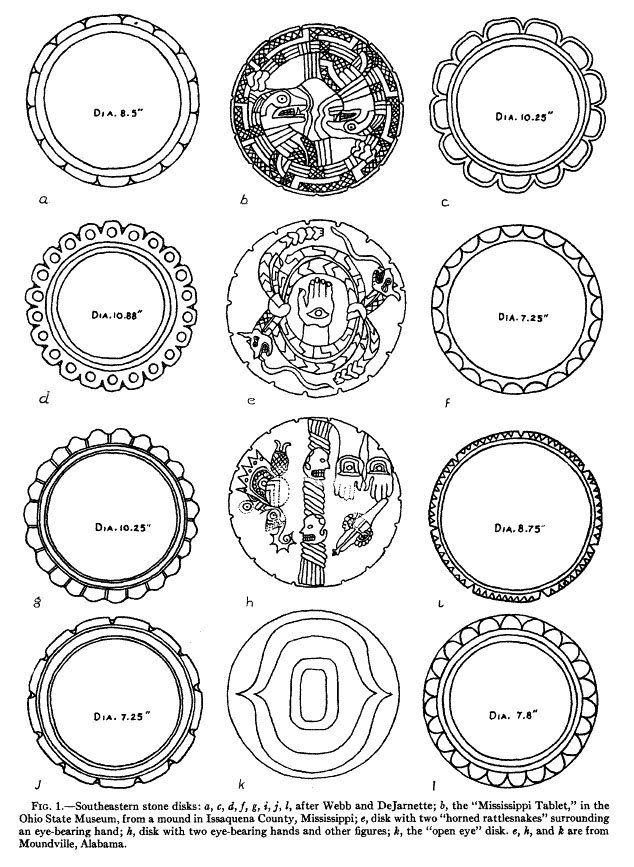
There is now some question about the existence of Mound 13. Melvin L. Fowler writes:
'These four mounds, as numbered on the Patrick Map and followed by Moorehead, must be considered as a group (Figure 4.10). There are major discrepancies between the Patrick locations of these mounds and indications on current aerial photographs and contour maps of the area. Patrick shows these basically as two pairs (13-14 and 15-16) just north of Monks Mound. Mound 14 is a large, oval-shaped mound, and 13 is a small, apparently conical mound. Mound 16 is a large oval with a platform top, and Mound 15 is a large (compared to 13) conical mound. Recent maps and field studies indicate, however, that there are remnants of two mounds in the positions Patrick numbers Mounds 14 and 16, and another mound to the west, approximately halfway between what Patrick labels Mounds 13 and 15. 1 can identify only three mounds in this group, not the four that Patrick has numbered'. See: THE CAHOKIA ATLAS- A Historical Atlas of Cahokia Archaeology, by Melvin L. Fowler, 1989, pg.74.
Despite this reservation on Fowler's part, the location marked on the UWM map to indicate Mound 13's position seems to comply favourably to ancient coding. The marked position sits 1890' out from Monk's Mound hub @ a return angle of 161.8034-degrees (PHI coding).
The Great Pyramid, with a side value of 756', is 189' X 4. The value 1890 was highly important for solar month and lunar month counts on the ancient Druidic brass plaque called the Calendar of Coligny (a lunisolar Sabbatical Calendar). The huge panel was divided into 128 boxes of half months, with 2 CIALLOS intercalary months that could be pressed into service as required. To do the solar count the calculation went: 1890-days ÷ 63 = 30-days per month. To do the lunar count the calculation was 1890-days ÷ 64 = 29.53125-days per lunar month.
The sum of 189' would be 1/32nd of 1-minute of equatorial arc and the sum of 1890' would be 5/16ths of 1-minute of arc.
The return angle to Monk's Mound hub codes the PHI ratio @ 1: 1.6180339. It was very common to code this ratio on the open-air-university sites in expanded values such as PHI X 100, as in this case. There was also a huge amount of usage of 1.62 or 16.2 or 162 and this "rounded" expression of the PHI ratio is an essential value in ancient metrology.
Mound 14 sits a coded distance of 1866.24' from the hub of Monk's Mound @ 176-degrees return and in both distance and angle the coding is navigational. With the Earth's equatorial circumference set to 24883.2 Greek miles of 5250' each, the total tally of feet is 130636800 or 186624' X 7.
The degree angle coding relates to the English mile of 5280' (1760 yds).

Mound 15 sits out from Monk's Mound hub 1555.2' @ 337.5-degrees.
The distance aspect of Mound 15 codes the equatorial size of the Earth in a dynamic way. With the Earth configured to be 24883.2 miles in circumference, the sum of 1555.2-miles would be 1/16th of that circuit or 22.5-degrees of arc.
A mathematical progression based upon 337.5 will produce strings of very useful and essential lunar and navigational values. Also, this degree angle constitutes one of the very important fix-points of the compass:
0 (N), 22.5 (NNE), 45 (NE), 67.5 (ENE), 90 (E), 112.5 (ESE), 135 (SE), 157.5 (SSE), 180 (S), 202.5 (SSW), 225 (SW), 247.5 (WSW), 270 (W), 292.5 (WNW), 315 (NW), 337.5 (NNW), 360 (N).
Mound 16 sits 1066.6666' out from Monk's Mound hub @ 168.75-degrees return. This distance value (1/3rd of 3200) or lesser expressions of the same, were much used in navigational calculations. The old French foot was 1.066666' or 12.8". Distance readings onto this mound would also have included tutorials related to the merits of 1050' (100 reeds) and 1080' (strong navigational value).
The return degree angle from Mound 16 is, essentially, the same kind of coding as is contained within the 337.5-degree outrunning angle to Mound 15 and 168.75 X 2 = 337.5.

Mound 17 sits very close to Monk's Mound and the centre-to-centre distance is 800' @ 40-degrees azimuth.

Mound 18 sits a coded distance of 1134' from the hub centre of Monk's Mound @ an azimuth angle of 72.9-degrees. Both the distance and angle readings are dynamic lunar coding.
Herodotus, Greek Historian was told by Egyptian priests that the Great Pyramid was 800' long. The foot they were referring to was 11.34" (756' ÷ 800 = 11.34"). Three sides of the Great Pyramid @ 756' per side = 2268' (1134' X 2). The design width of the Station Stone's rectangle at Stonehenge is 113.4'.
The 6804-day duration of lunar nutation cycle (where the Moon goes from Lunar Major Standstill to Lunar Minor Standstill, then returns to Lunar Major Standstill again is 6 periods of 1134-days. In the 2551.5-days (lunar period of 7.2 lunar years) monitored alongside 2556.75-days (7 solar years) in the ancient lunisolar Sabbatical Calendar, there were 22.5 intervals of 113.4-days. This meant that the lunar period was easily tracked within a 360-degree environment (22.5-degrees is 1/16th of 360-degrees). There would be 3.125 (31/8th) intervals of 113.4-days in a lunar year.
This value was multi-use and featured very strongly in ancient lunar or navigational computations. For example, the sum of 1134' would be 11.25 seconds of equatorial arc (100.8' per second) for the Earth and the sum of 11.25-degrees is 1/32nd of 360-degrees. It was by mathematical associations like this that everything was calibrated and tracked within various circuits during ancient times. Let's look at some ancient tracking and computing stone discs excavated from the North American mounds.

The ancient Moundbuilder mathematician-navigator-astronomers of North America were doing many kinds of counts and calculations, using all of the number families. For this exercise they fabricated many variations of stone disks, with calibration notches or pattern segments around the perimeter. These discs could then act as mnenonic devices or aids in remembering the "times-table" progression of numbers associated with particular cyclic counts. Let's review how the above stone discs would have been used:
a. This disc has 15 segments and 15 notches. A dot on one of the segments probably relates to alternative counts using progressions of, say, 1512 (Earth's equatorial circumference), etc., The 15 segments work fluidly in a 360-degree environment, where each segment represents 24-degrees of arc.
b. This calibration (15) duplicates disc a.
c. This disc has 13 segments and notches and would have been used for calendar computations. Under a Sabbatical Calendar count, used by many ancient civilisations, there were 13 months of 28-days each in a year (364-days). This count ran for 7 solar years, wherein the missing 9-days (8.75 actual) were added back in during a festival and the count (now fully corrected) recommenced.
d. This disc has 22 segments and notches and would have been used for counts within the "11" family of navigational values, like the 5280' mile (22 X 240). The disc would have been useful for remembering the 24750-mile circumference of the Earth as 22 X 1125-miles.
e. This disc has 17 segments and notches and would have been used for lunar counts within the 6804-day lunar nutation cycle (1701-days X 4). The use of intertwined dual snakes in the design or the "all-seeing eye" is very reminiscent of ancient Egyptian cultural symbolism or that of Scandinavia.
f. This disc has 23 segments and pointers and would have been used to remember the 24883.2 Greek mile equatorial circumference of the Earth (130636800'). One of the very important mathematical progressions of antiquity is the 1152 one, which goes 1152, 2304, 3456, 4608, 5760, 6912, 8064, 9216, 10368, etc. At Stonehenge the outer rim of the Sarsen Circle measures 345.6' or 11.52 feet (average length) per lintel stone (30 overhead lintel stones) or 23.04' per two lintel stones. The disc would have been used on the basis of 23.04 X 5670000 (half of 11340000) = 130636800'.
g. This disc also has 23 segments and notches and works to 23.04.
h. This disc has 20 segments and notches, each representing 18-degrees of arc. It could also have served as an aid in calculating minutes of arc if configured to work to the value 20.16. Note: 2016' is 1/3rd of 6048' (1-minute of equatorial arc).
i. This disc is septimal, with seven segments and notches. It would have been used for calendar and navigational computations and especially for computing the lunar cycles by assigning various values to the segments.
j. This disc has 13 segments and notches and would have been used in calendar computations.
k. This disc is another "open-eye" design, like the "all seeing eye of Horus", as found on other of the North American mound discs.
l. This disc is yet another that works to progressions of 23.04.
See: Vol. XII, American Antiquity, July 1946, No 1, pg. 9, Article title: Stone Disks As Treaty Suns.
Mound 18 continued:
The angle out to Mound 18 is 72.9-degrees and this is strong navigational coding and lunar coding simultaneously. The Bush Barrow Lozenge artefact recovered near Stonehenge is 7.29" long or 1/8th of a Roman Pace of 58.32" (but dates to 3000 BC, which is over 2500-years before there was a thriving and robust Roman civilisation). The Roman foot was 11.664" and 7.29" is 5/8ths of their foot. The ancient Egyptian Theban volume was 11664 cubic inches or 729 cubic inches X 16.